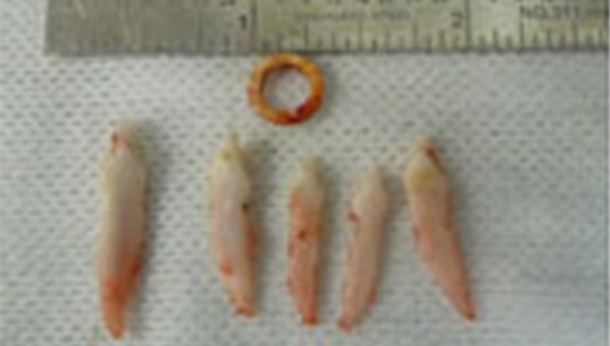Orthodontics and bite defects are a common reason for referral. The most common condition we see is lingual displacement of the lower canine teeth with consequent hard palate trauma with an inability to close the mouth. We have a separate page devoted this problem. Use this link - Lingually Displaced Lower Canines.
Please note that we will not perform cosmetic orthodontics or place braces in show dogs. See below for our policy with regards to ethics.
"Home Orthodontics" is dangerous to your pet. The use of bands and wires without proper supervision often causes teeth to be lost due to highly abnormal forces out of control.

The dog above was referred because of the abnormal position of the lower incisors. Differential diagnoses included trauma with a blunt object or high speed collision with another dog. How wrong we were!

Our radiographs showed no actual trauma but complete avulsion of the teeth out of the sockets. The reason was the use of a powerful elastic band placed to straighten the teeth. The elastic band had slipped down the teeth and below the gum line. Once down there it pulled all five teeth out of their sockets and caused local bone damage by cutting off blood circulation. Apart from removal of the teeth extensive bone recontouring was required to remove dead bone and allow recovery.
Most cases are referred simply for a bite appraisal. Genetic counseling is an integral part of this consultation with written reports are provided for the owner and referring veterinary surgeon. These specialist reports often help clients in disputes with the breeder and, for breeders, in the future selection of stud animals. These are "expert reports" and can be used in legal disputes. An article written by us was published in Veterinary Times in December 2006. A PDF is available to download here.
The most common defects we see are:
Lingually displaced canine teeth - this is so common there is a separate page.
"Lance canines" (or rostroversion) of upper canines.
A common condition in Shetland sheepdogs. Upper canines are in rostroversion and point forward like a lance. The teeth are often semi-erupted and located across the face with the root apex in the nasal cavity. Usually surgical extraction is the most reliable course of action. Any oral nasal fistula can be corrected at the time of surgery.
Note the case below. The radiograph shows the extent of the impaction of the canine, which is unable to erupt, on the third incisor tooth.

See our PowerPoint file for further information about the procedure.
Rostral cross bite: some or all of the lower incisors forward of the uppers.
We do not perform orthodontics in these cases as the condition is most often due to a combination of long lower jaws (relative to the upper jaw) plus excessive crowding of the incisors. The correct term is mandibular mesioclusion or class 3 bite but undershot is the term in common use.
Since the origin is inherited, and does not cause pain or discomfort to the pet, long, involved and expensive treatment cannot be considered to be in the pets' best interest in our opinion.

Our primary duty is to the patient and their welfare. Bite defects often cause pain and discomfort and dealing with this is our main concern.
Ethics
There are several ethical concerns that have to be satisfied before undertaking any orthodontic treatment that may change the appearance of an animal with a bite defect. We are obliged to inform the Kennel Club of actions we take to alter the natural conformation of a dog. Potential clients are requested to download the form, complete it and bring it with you on the day. We also need your microchip number.
In the past we have had some clients who have refused to sign this form and have effectively wasted a long journey. It may be worth pre-warning potential referral clients before they travel.
It is very important for the welfare of the breed in general that an individual with a bite defect is not allowed to breed. To that end, major orthodontic work cannot be performed unless the animal has been neutered.
Many of these conditions are autosomal recessive mutations. This means that normal looking individuals can carry hidden recessive genes. If they mate with another recessive carrier there will be both normal and abnormal pups in the litter. Currently there are no tests available to identify a recessive carrier other than test mating.
If in doubt contact us first before travelling.